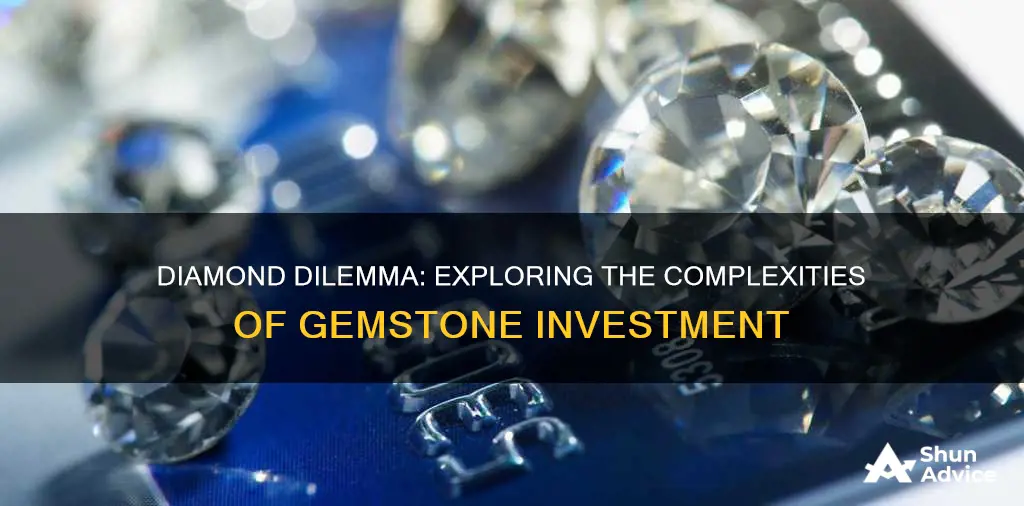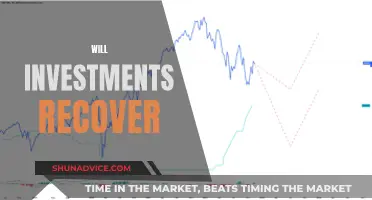
There are several factors to consider when asking whether buying diamonds is a good investment. On the one hand, diamonds are valuable because they are rare and in high demand. They are also highly condensed in value, making them easy to store and transport. Additionally, diamonds are durable, inflation-proof, and can be insured. However, there are some disadvantages to investing in diamonds. The market for diamonds is illiquid, and there is a lack of transparency in pricing and tradability. Overall, while diamonds may have some benefits as an investment, it is important to carefully consider the potential risks and downsides before making any decisions.
What You'll Learn

Diamonds are a depreciating asset
Firstly, diamonds are not easily tradable. Buying diamond jewellery is much easier than selling it. While some companies do buy diamonds, the price they are willing to pay will be lower than the price you bought them for. Retail stores rarely buy back diamonds from consumers because they don't want to risk capital on diamonds that may never be resold.
Secondly, there is a lack of transparency in diamond pricing. Unlike gold, there is no universal price per gram for diamonds. The industry refers to price guides, such as the Rapaport Diamond Report, which is not readily available to consumers and investors. The price of a diamond is influenced by its carat, colour, clarity, and cut—the 4 Cs. However, the price is ultimately determined by the market based on supply and demand.
In addition to the lack of transparency, there is also a lack of standardisation in the buy-back value of diamonds. The discount on the buy-back value can range from 15-35%, depending on the buyer's opinion of the stone. This makes it difficult for consumers to know the true value of their diamonds and whether they are getting a fair deal when selling them back.
Overall, while diamonds may have some advantages as an investment, such as their small size, durability, and inflation-proof nature, the lack of tradability and transparency in pricing makes them a depreciating asset.
Retirement Investment Strategies: Navigating Your Options
You may want to see also

The resale market for diamonds is illiquid
Firstly, diamonds are not fungible. The value of a diamond is determined by its individual characteristics, particularly the 4 Cs: carat weight, colour, clarity, and cut. This means that two diamonds of the same carat weight can have very different values depending on the other three Cs. This makes it difficult to establish a uniform and readily understood pricing system, and therefore a liquid market.
Secondly, there is a lack of price transparency in the diamond market. While there are price guides, such as the Rapaport Diamond Report, these are not readily available to consumers and investors. The price of a diamond is ultimately determined by the market based on supply and demand, and this can vary greatly. For example, an industry expert estimates that a half-carat diamond ring costing $2000 at a retail store could be sold back to a wholesaler for only $600.
Thirdly, most diamonds are sold through retail stores at a high margin, and these stores are often unwilling to buy back diamonds from consumers. This is because retailers usually receive their diamonds from wholesalers and don't need to pay for them until they are sold, so there is no point in risking capital on customer diamonds that may never be resold. Additionally, retailers don't want to make a low offer to diamond consumers as this would undermine the notion that diamonds are a good investment.
Finally, the resale market for diamonds is illiquid due to the lack of a terminal market. Most commodities have a terminal market, some form of commodities exchange, clearing house, and central storage facilities. Until recently, this did not exist for diamonds, further reducing their effectiveness as an investment medium.
Your Investment Mix: Balancing Risk and Reward
You may want to see also

Diamonds are inflation-proof
The value of diamonds is influenced by their carat weight, colour, and clarity, often referred to as the 4 Cs. The fewer imperfections a diamond has, the higher its clarity grade and value. The cut of a diamond controls its brilliance, so a better cut results in more sparkle. The weight of a diamond is measured in carats, with the unit price referred to as "per carat". The last of the 4 Cs is the colour of the diamond, or rather the lack of it. White or colourless diamonds are the most valuable.
The size of a diamond is a significant advantage over other commodities such as gold. Diamonds are small and easy to store, even those worth hundreds or thousands of dollars. Their small size also makes them an excellent means of money transfer. A diamond, no matter how small, can be worth double or triple a similar-sized piece of gold jewellery.
The durability of diamonds is another advantage as they are the hardest substance on Earth. You can be sure that nothing will happen to a diamond as long as you take good care of it. You can even insure your diamonds if you are worried about losing them.
Diamonds are also a more movable and durable investment than other physical commodities. They are an investment one can see, hold, and wear, making people feel safer than with stocks and other digital investments.
Retirement Planning: The Perils of Starting Too Soon
You may want to see also

Diamond prices are determined by the market
The price of a diamond is influenced by various factors, including its carat weight, colour, clarity, and cut, often referred to as the "4 Cs". The characteristics of individual diamonds can significantly impact their value, and transactions can vary depending on global trends and the specific market. For example, since 2008, larger diamonds have appreciated better than smaller ones, and rare "fancy coloured diamonds" such as yellows, pinks, blues, and greens have proven to be a secure investment.
The lack of price transparency in the diamond market is a common concern. Unlike commodities such as gold, which have a widely followed price index, diamonds do not have a standardised pricing system. The Rapaport price list is a benchmark used by many diamond dealers, but it only considers basic factors like carat weight, clarity, and colour. Ultimately, the price of a diamond is determined by market forces, and merchants may buy and sell diamonds above or below the price list based on supply and demand.
Additionally, the resale market for diamonds is considered nearly illiquid, making it challenging for consumers to sell their diamonds back to retailers or wholesalers. The high retail markup on diamonds, typically between 100% and 200%, discourages stores from buying back diamonds from consumers. As a result, consumers often have to accept a significant discount when selling their diamonds, further reinforcing the notion that diamond prices are highly dependent on market conditions and the specific buyer and seller involved in the transaction.
Safe Havens: Where to Invest Now
You may want to see also

Diamond investments require patience
Diamonds are a relatively new obsession, and while they are valuable because they are rare and in high demand, without that demand, they would be worthless.
There are several reasons why diamonds are not a good short-term investment. Firstly, there is a lack of price transparency. Unlike gold, there is no universal price per gram for diamonds, and no hallmarking system. The price of a diamond depends on its individual characteristics, especially the carat weight, colour, and clarity, and transactions are usually private. While there is a Rapaport price list, it is not comprehensive, and diamond prices are ultimately determined by the market.
Secondly, there is a lack of tradability. It is much easier to buy diamonds than to sell them, and most retailers will not buy back diamonds from consumers as they have no use for them. The few companies that do buy diamonds will offer a lower price than what you paid for them.
Finally, the resale market for diamonds is illiquid. Diamonds do not have a terminal market, and there is no standard quality available in sufficient quantity to be easily tradeable. This, along with the many variables in diamond quality, makes commodity-like pricing difficult.
For these reasons, diamonds are not a good short-term investment. However, if you are willing to wait for gains, they can be a good long-term investment, especially in a growing market.
Insurance: A Safe Investment Bet?
You may want to see also
Frequently asked questions
Diamonds are a great investment option due to their size, storability, and durability. They are also inflation-proof and can be enjoyed while being used as an investment.
There is a lack of price transparency and tradability when it comes to diamonds. They are also not a good option for those looking for quick returns or short-term investments.
Diamond investment should be a small portion of your portfolio. Learn the basics of diamond language, set a budget, and diversify your diamonds by not putting all your eggs in one basket.
Diamonds as an investment have their pros and cons. While they offer advantages such as size, storability, and durability, there are also risks involved, including lack of price transparency and tradability.







